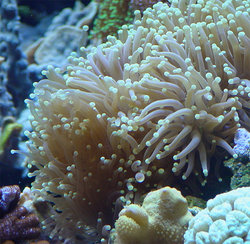Symbiosis
|
|
Symbiosis is an interaction between two organisms living together in more or less intimate association or even the merging of two dissimilar organisms. The term host is usually used for the larger (macro) of the two members of a symbiosis. The smaller (micro) member is called the symbiont (alternately, symbiote, and the plural is symbionts or symbiotes). When a microscopic symbiont lives inside a host, it is referred to as an endosymbiont.
The various forms of symbiosis include: -
- parasitism, in which the association is disadvantageous or destructive to one of the organisms and beneficial to the other (+ -)
- mutualism, in which the association is advantageous to both (+ +)
- commensalism, in which one member of the association benefits while the other is not affected (+ 0)
- amensalism, in which the association is disadventageous to one member while the other is not affected (- 0)
In some cases, the term symbiosis is used only if the association is obligatory and benefits both organisms. Symbiosis as defined in this article does not restrict the term to only the mutually beneficial interactions.
Symbiosis may be divided into two distinct categories: ectosymbiosis and endosymbiosis. In ectosymbiosis, the symbiont lives on the body surface of the host, including the inner surface of the digestive tract or the ducts of exocrine glands. In endosymbiosis, the symbiont lives either in the intracellular space of the host or extracellularly.
An example of mutual symbiosis is the relationship between clownfish of the genus Amphiprion (family, Pomacentridae) that dwell among the tentacles of tropical sea anemones. The territorial fish protects the anemone from anemone-eating fish, and in turn the stinging tentacles of the anemone protect the anemone fish from its predators (a special mucus on the anemone fish protects it from the stinging tentacles).
Another example is the goby fish, which sometimes lives together with a shrimp. The shrimp digs and cleans up a burrow in the sand in which both the shrimp and the goby fish live. The shrimp is almost blind leaving it vulnerable to predators when above ground. In case of danger the goby fish touches the shrimp with its tail to warn it of imminent danger. When that happens both the shrimp and goby fish quickly retract into the burrow.
A famous land version of symbiosis is the relationship of the Egyptian Plover bird and the crocodile. In this relationship, the bird is well known for preying on parasites that feed on crocodiles which are potentially harmful for the animal. To that end, the crocodile openly invites the bird to hunt on his body, even going so far as to open the jaws to allow the bird enter the mouth safely to hunt. For the bird's part, this relationship not only is a ready source of food, but a safe one considering that few predator species would dare strike at the bird at such close proximity to its host.
The biologist Lynn Margulis, famous for the work on endosymbiosis, contends that symbiosis is a major driving force behind evolution. She considers Darwin's notion of evolution, driven by competition, as incomplete, and claims evolution is strongly based on co-operation, interaction, and mutual dependence among organisms. According to Margulis and Sagan (1986), "Life did not take over the globe by combat, but by networking". As in humans, organisms that cooperate with others of their own or different species often outcompete those that don't.
However, mutualism, parasitism, and commensalism are often not discrete categories of interactions and should rather be perceived as a continuum of interaction ranging from parasitism to mutualism. In fact, the direction of a symbiotic interaction can change during the lifetime of the symbionts due to developmental changes as well as changes in the biotic/abiotic environment in which the interaction occurs.


